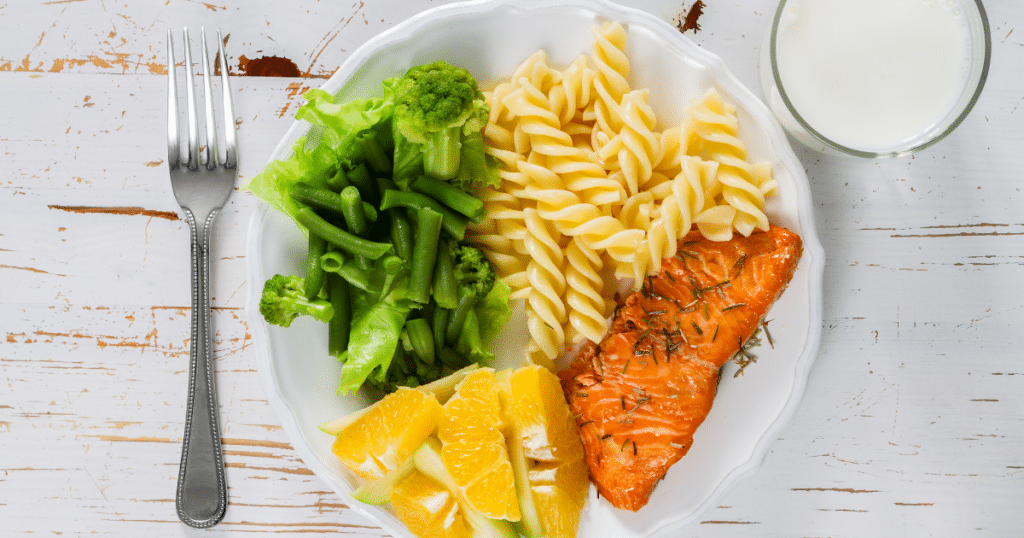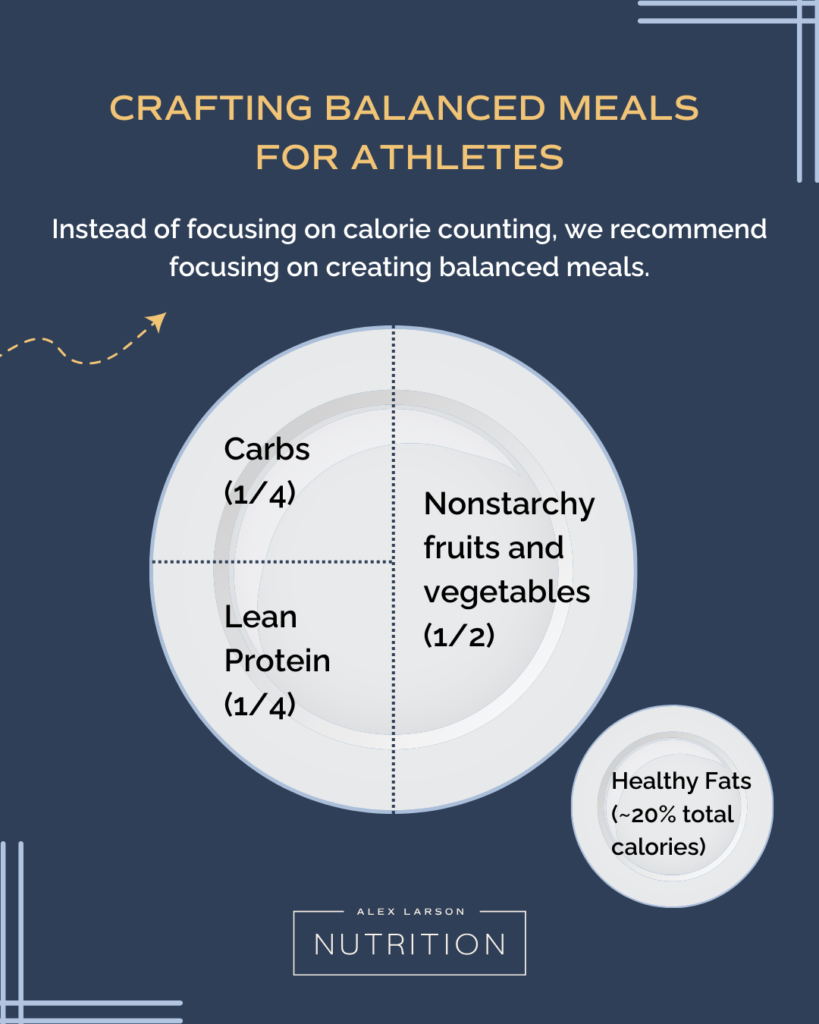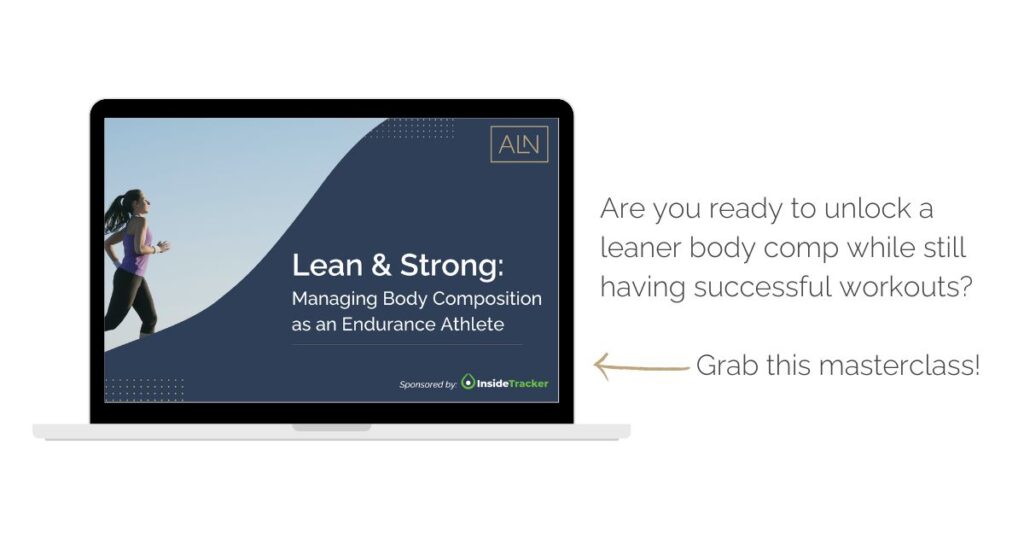RUNNING →
Level Up Your Nutrition Game With Our Freebies
Alex
I provide nutrition coaching for endurance athletes to improve performance and body composition through a simple and flexible eating style.
Hi, I'm
ATHLETE EATING GUIDE →
PROTEIN →
TRIATHLON →
RECIPES →
PERFORMANCE NUTRITION →
SUPPLEMENTS →
HOLIDAY & TRAVEL →
PLANT-BASED →
FEMALE ATHLETE NUTRITION
Explore the Blog
LEARN MORE →
ATHLETE GROCERY SHOPPING GUIDE →
RACE DAY: TRIATHLON NUTRITION PLANNER →
READY TO FUEL?
incredible value!
The fueling guide bundle serves as your one-stop-shop for strategies to fueling before, during and after your workouts.
ENDURANCE EATS
BINGE-WATCH READY!
YOUTUBE SERIES
Many endurance athletes desire to shed unwanted pounds to make themselves a more competitive athlete. The good news is that calorie counting is not a requirement to achieve your goals. Let’s dive into how to lose weight without counting calories. In this article, we’ll focus on other tools to keep in your toolbox to help support a leaner endurance athlete body composition.
The Endurance Athlete’s Body Composition Dilemma

We have countless endurance athletes who enter the ALN 1:1 nutrition coaching program intending to improve body composition. So we get it! You’re among many endurance athletes looking to gain that competitive edge for race season.
Cycling and running require athletes to work against gravity. So generally speaking, when it comes to working against gravity, less body weight implies less overall work. Carrying less body weight may also carry a lower injury risk both short and long-term. Improving and optimizing body composition is just one part of the puzzle, among many others, for enhancing endurance performance. Research shows that reducing nonessential body fat can also contribute to muscular and cardiorespiratory endurance, speed, and agility development.
While achieving and maintaining a lean body composition can be helpful for performance, unfortunately, there can be a fine line between achieving those results and chronic underfueling. Underfueling in the long-term can result in less-than-ideal consequences such as RED-S.
RED-S
RED-S can be caused by one or a combination of two things: not eating enough and/or exercising too much. When there is an imbalance in your dietary intake vs. energy expenditure, you can start to experience impaired bodily functions. Next, your body will begin adjusting your body systems to compensate for the lack of energy. This can have metabolic, hormonal, and functional effects. It is a no-brainer that the signs and symptoms above can impact your overall quality of life, and also start to affect your sports performance. RED-S can be a significant hit to your ability to perform at your best as an athlete. The condition can be sad and frustrating to deal with.
First off, when you have low availability of energy for extended periods, you can begin to develop nutrient deficiencies. Nutrient deficiencies lead to a whole host of negative effects, including chronic fatigue and an increased risk of illness and infections.
Second, current research shows that athletes with low energy intakes experience a reduction in protein synthesis. Since protein synthesis is essential for maintaining and building muscle, athletes who experience a reduction can lose muscle mass and take longer to recover from training sessions.
Lastly, many of the consequences of RED-S on sports performance have to do with its impact on your bone health. RED-S alters the hormones inside your body, increasing stress hormones such as cortisol and decreasing estrogen and testosterone. This has been shown to have adverse effects on bone density and bone formation leading to potentially irreversible bone loss in athletes. A loss in bone density can increase your risk for bone fractures and other prominent injuries.
Prioritizing Periodization
If you are looking to improve your body composition, to lose weight without counting calories, we recommend doing so during the off-season. The reason for this is to not negatively affect your training and performance in races. Endurance athletes often prioritize fat loss during the off-season rather than in-season to maximize performance gains.
In the off-season, there’s more flexibility to adjust nutrition and training plans without the pressure of upcoming races. This approach allows endurance athletes to build a solid foundation of fitness, improve body composition, and develop sustainable habits. Shedding nonessential body fat during the off-season can also reduce the risk of overtraining and injury, ensuring a healthier and more successful in-season performance.
Crafting Balanced Meals for Athletes

Instead of focusing on calorie counting, we recommend focusing on creating balanced meals. The daily rigors of your physical efforts demand optimal nutrition. A well-rounded diet ensures athletes receive essential macronutrients like protein, carbohydrates, and fats, each playing a unique role in energy production and recovery. When pursuing body composition goals, be sure to include the following:
Lean Protein (¼ of your plate)
While protein is always important for endurance athletes, it is especially important while pursuing body composition goals because it provides fullness. Depending on your activity level and body composition goal, you may require upwards of 2.0g of protein per kilogram of body weight. This should be spaced throughout the day in regular intervals between meals and snacks. Lean protein-rich food sources will be your best bet versus higher-fat protein sources. So be sure to regularly include: poultry, fish, extra lean beef, eggs, egg whites, Greek yogurt and cottage cheese, tofu, tempeh, seitan, edamame, legumes, and protein powder and bars. If you find yourself constantly short on meeting your protein needs, consider utilizing our high-protein breakfast, lunch, and snack guides for tasty ideas.
Carbohydrates (¼ of your plate)
Carbohydrates will provide you with the energy you need to fuel those workouts. When you consume carbohydrates, your body breaks the food into glucose (sugar) and either uses it for activity (i.e. a run or ride) or converts it into glycogen to be used later. Typically, most endurance athletes in season require at least 55% of their calorie intake from carbohydrates though this is generally decreased while chipping away at body composition goals. It is important to recognize that not all carbohydrates are the same.
Simple carbohydrates:
Easy-to-digest including raw sugar, energy gels, sports drinks, fruit and juice, candy, and foods with added sugars. Foods that are high in simple carbohydrates are low in fiber and break down quickly to be used as energy. These foods are effective while training to provide quick bursts of energy. It is important to still include simple carbohydrates during exercise, even if you are pursuing body composition goals.
Complex carbohydrates:
Complex carbs take longer to digest and are found in higher fiber, nutrient-dense foods such as whole grains, legumes, and starchy vegetables such as sweet potatoes, among others. These foods are excellent to include throughout the day in meals and snacks to boost your vitamin and mineral intake and help keep you feeling satisfied, especially if you are managing a heightened endurance athlete appetite. Opt for higher fiber grains including oats, quinoa, barley, and whole wheat pasta, among others to keep you feeling satisfied.
Nonstarchy Vegetables and Fruits (½ of your plate)
If you are looking to lose weight without counting calories, vegetables and fruits are essential. Nonstarchy vegetables and fruits are nutrient-dense versus energy-dense and provide vitamins, minerals, electrolytes, and dietary fiber. Research has also shown that regular fruit and vegetable consumption decreases the risk of heart disease, many cancers, and osteoporosis, among many other health conditions.
Achieving the recommended 5 servings of fruits and vegetables daily can be difficult to attain if you are not meal planning and packing ahead. To easily boost your intake, toss in a handful of spinach to your morning egg scramble, an extra serving of raspberries to your post-workout smoothie, or enjoy an extra large side salad at dinner. Even seemingly easy and basic strategies add up over time!
But Don’t Skimp on Healthy Fats
Healthy dietary fats are vital to reducing inflammation, helping with vitamin absorption, and promoting joint health. Typically ~20-30% of your diet should be composed of healthy anti-inflammatory fat sources. However, the lower end of the range is recommended if you are working on your body composition. Including olive oil, nuts and seeds, olives, avocado, and oily fish such as salmon are easy ways to boost your healthy fat intake. Flaxseed, chia seed, and walnuts are extremely rich sources of omega-3 fatty acids. Consider adding flaxseed to your morning smoothie or in a batch of no-bake protein energy bites, an ALN favorite!
Creating balanced meals tailored to the specific needs of endurance athletes is a fundamental component of their success, providing the energy, nutrients, and resilience necessary to excel in their demanding endeavors.

Use Your Best Discretion
Reducing discretionary calorie intake is important for successful weight loss. Examples of discretionary calories can include sugary beverages, and high-fat, low-nutrient foods such as deep-fried foods, baked goods, etc. By limiting these indulgences and replacing them with nutrient-dense options like fruits, vegetables, and lean proteins, individuals can create a calorie deficit, promoting fat loss and healthier eating habits. While it is important to allow yourself to include these foods that you enjoy, implementing mindful eating practices can also be helpful for weight loss without counting calories.
Mindful Eating Practices that May Help

Mindful eating practices generally promote a healthier relationship with food and can help you lose weight without counting calories. Furthermore, these practices offer a helpful approach to supporting weight and fat loss by fostering a heightened awareness of one’s eating habits. When individuals practice mindfulness while eating, they become more attuned to their body’s hunger and fullness cues, helping them distinguish between physical hunger and emotional cravings.
By slowing down and savoring each bite, they can better appreciate the taste and texture of their food, leading to increased satisfaction and reduced overeating. This mindfulness also encourages individuals to make conscious food choices, opting for nutrient-dense, whole foods over processed and calorie-laden options. A few specific mindful eating strategies that you may find helpful:
- Set your fork down between bites and pause
- Thoroughly engage your senses during the eating process– what does the food smell like? Taste like?
- Chew your food completely and thoroughly
- Eliminate distractions such as television, cell phones, and iPads
- Check-in with your hunger and fullness cues. Eat until you are content and satisfied versus overly stuffed
- Challenge yourself and sit at the table versus in your car or on the sofa
Mindful eating enhances the overall eating experience, making it more enjoyable and less stressful. By reducing stress levels and emotional eating triggers, individuals can break free from unhealthy patterns and establish a more balanced relationship with food. Over time, these mindful eating practices can lead to sustainable weight loss. As individuals develop a better understanding of their dietary needs, improve portion control, and make informed choices that align with their health goals.

Other Important Factors to Consider
Hydration, sleep, and stress management also play pivotal roles in the weight loss journey for endurance athletes.
- Hydration. Staying adequately hydrated is crucial as dehydration can hinder performance and metabolism, making it harder to shed excess pounds.
- Sleep. Sufficient sleep is equally vital, as it aids in muscle recovery, hormone regulation, and appetite control. Chronic sleep deprivation disrupts these processes and can lead to overeating and weight gain.
- Stress Management. Effective stress management is key, as high-stress levels can trigger emotional eating and hormonal imbalances that hinder weight loss efforts.
In the demanding world of endurance sports, prioritizing these aspects is essential for achieving and maintaining a healthy weight while optimizing athletic performance.
Putting the Puzzle Pieces Together
There is no one-size-fits-all approach to losing weight and improving your body composition. Fortunately, you can get achievable and sustainable results, it is possible to lose weight without counting calories. If you want to improve your body composition and don’t know where to start, be sure to reach out. We provide personalized accountability and strive to teach you how to create a sustainable and flexible eating style to meet your needs as an endurance athlete.
Alex
I provide nutrition coaching for endurance athletes to improve performance and body composition through a simple and flexible eating style.
Hi, I'm
LEARN MORE →
take the quiz!
Let's discover your Endurance Nutrition IQ
How well do you know your fueling? Answer these questions and let's see where your endurance nutrition knowledge is at!
Take the quiz
level up your nutrition game with these freebies
free downloadS
Protein-Packed 10-Day Sample Meal Plan
Athlete Eating Guide
Athlete Grocery Shopping Guide
1
2
3
Inspiration to fit 120 grams of protein into your day
Planning what goes on your plate
Putting the right foods in your grocery cart
